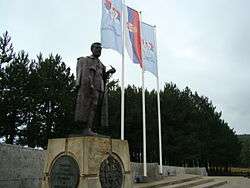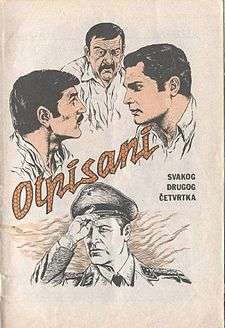Žarko Todorović
| Žarko Todorović | |
|---|---|
| Native name | Жарко Тодоровић |
| Nickname(s) | Valter[1] |
| Born |
1907 Belgrade, Kingdom of Serbia |
| Died | Paris, France |
| Allegiance |
|
| Rank | |
Žarko P Todorović "Valter" (1907 Belgrade — Paris)[2] was one of the leaders of the Intelligence service of Chetniks in the first phase of World War II in the German occupied Yugoslavia and first commander of the undercover Chetnik headquarter in Belgrade.[3][4][5][6] According to former Chetnik officer Milan Deroc, the HQ Belgrade Command was established based on the secret list of Yugoslav military officers who returned from April war, composed by Žarko's brother, Boško Todorović.[7] Žarko organized connection of the Chetnik movement with British Intelligence and Yugoslav government-in-exile.[8] He sent a report about the establishment of the core of rebels against German occupation in Yugoslavia on Ravna Gora, presenting the initials of the commander of the uprising (D.M.) and providing short and long wave frequencies for communication.[9] The message bore signature of General Staff Major Z.P.T. whose handwrinting was recognized to be of Žarko Todorović.[10]
Before Second World War
Before the Second World War, Todorović was a Major in the Army of the Kingdom of Yugoslavia who worked in the Intelligence of the Supreme Command.[11]
Resistance at Ravna Gora

On 8 May 1941 a group of former Yugoslav officers established the first resistance movement on Ravna Gora which was nominally led by Draža Mihajlović.[12] In May 1941 Todorović delivered an invitation to Dragomir Jovanović of Draža Mihajlović to join Chetniks.[13]
Žarko organized connection of the Chetnik movement with British Intelligence and Yugoslav government-in-exile.[14] He sent a report about the establishment of the core of rebels against German occupation in Yugoslavia on Ravna Gora, presenting the initials of the commander of the uprising (D.M.) and providing short and long wave frequencies for communication.[15] The message bore the signature of General Staff Major Z.P.T. whose handwriting was recognized to be of Žarko Todorović.[16] At his 1946 trial, Mihajlović stated that Todorović made contact with the American Legation.[17]
Todorović also organized a radio communication between Stanislav Rapotec and Mihajlović.[18] The delegate of Yugoslav government in exile Jovan Đonović reported to Masterson, the chief of the Belgrade mission of British intelligence, that Todorović (code-name ZPT — from Žarko P Todorović)[19] organized the committee of thirty two (the Central National Committee).[20]
Todorović was one of the leaders of the Intelligence service of Chetniks in the first phase of World War II in the German occupied Yugoslavia and first commander of the undercover Chetnik headquarters in Belgrade.[3][6][21][22] According to former Chetnik officer Milan Deroc, the HQ Belgrade Command was established based on the secret list of Yugoslav military officers who returned from April war, composed by Žarko's brother Boško Todorović.[23]
In July 1941 Todorović started with activities aimed to establish Chetnik undercover organization in German occupied Belgrade.[24]
First arrest
While Todorović was in the position of commander of Belgrade, Germans managed to break the code Todorović used to communicate with Mihajlović's headquarters, and based on received data they located and arrested Todorović.[25] The first official commander of Belgrade during World War II, Žarko Todorović, was arrested at the end of July 1941.[26] German officer Bader boasted in the report he sent to his superior commander that arresting of Todorović was a heavy loss for Mihajlović's organization in Belgrade.[27] He soon escaped. Against the order of the supreme command, Todorović went to Croatia after he entrusted position of the commander of Belgrade to Major Radoslav Đurić.[28] Since the command was often target of Gestapo activities, its composition was frequently changed and after Đurić the commander was Dušan Manojlović, Saša Mihajlovića and then again Žarko Todorović.[29]
Commander of Northern Provinces (Vojvodina and Slavonija)
According to Nikola Milovanović, Mihajlović established the Command of Northern Provinces already in 1941.[30] Until mid 1943 Todorović was a chief of the Command of Northern Provinces (Vojvodina and Slavonija).[31]
Second and third arrest
According to Nikola Milovanović, in February 1943 Gestapo decided to arrest Todorović after an illegal radio station was discovered in Belgrade. Milovanović emphasized that Todorović was transported to Zagreb for further interrogation where he again managed to escape from the prison thanks to helping of Ustaše intelligence officer Zvonko Katalinić and officer in Croatian Ministry of Internal Affairs, Dr. Damić.[32] After Todorović was released he was used by German attache with Croatian Ministry of Internal Affairs, Hans Helm, to trace other members of his intelligence network. They infiltrated their agent Radoslav Spitler as Todorović's courier who delivered to Helm copies of all Todorović's correspondence with Belgrade. As soon as Helm collected all data about Todorović's intelligence network, he arrested him again and sent him to Mathausen concentration camp.[33]
After Second World War
Todorović survived in Mauthausen until the end of the Second World War and decided to go to France where he lived as military officer of the French army until he was retired.[34] According to Deroc, Todorović was a Lt. Colonel in the French Foreign Legion.[35]
Legacy

In 2000's a series of reports was published in newspapers in Serbia, emphasizing that Todorovic's biography was inspiration for a famous Serbian TV series Otpisani.[36][37][38]
References
- ↑ Beograd u ratu i revoluciji 1941-1945. Istorijski arhiv Beograda. 1984. p. 2.
...Тодоровић Жарко-Валтер...
- ↑ Zbornik dokumenata i podataka o narodnooslobodilačkom ratu naroda Jugoslavije, tom 14 (četnička dokumenta), Vojnoistorijski institut, Beograd.
- 1 2 Matić, Milan B.; Vesović, Milan (1995). Ravnogorska ideja u štampi i propagandi četničkog pokreta u Srbiji 1941-1944. ISI. p. 16.
Обавештајном службом у тој почетној фази руководили су браћа Бошко и Жарко Тодоровић, мајори и капетан Александар Михаиловић, каснији командант Команде Београда.
- ↑ Istorija XX veka: zbornik radova. Narodna knjiga. 1959. p. 178.
U Beogradu je glavni bio Zarko Todorovic, tada major gene- ralátabni.
- ↑ Beograd u ratu i revoluciji 1941-1945. Istorijski arhiv Beograda. 1984. p. 462.
У Београду су деловали и обавештајни органи Команде северних покрајина Драже Михаиловића. ... Међутим, с обзиром да је командант те Команде био мајор Жарко Тодоровић „Валтер", који је и у бившој ...
- 1 2 Minić, Miloš (1993). Oslobodilački ili građanski rat u Jugoslaviji 1941-1945. Agencija "Mir". p. 78.
Михаиловић је у лето 1941. био формирао у Београду илегални четнички штаб под командом мајора Жарка Тодоровића.
- ↑ (Deroc 1997, p. 133)
- ↑ Zbornik dokumenata i podataka o narodnooslobodilačkom ratu naroda Jugoslavije, tom 14 (četnička dokumenta), Vojnoistorijski institut, Beograd.
- ↑ (Robertson 1999, p. 109)
- ↑ (Robertson 1999, p. 109): "...signed 'General Staff Major Z.P.T.', whom Simović immediately recognized by his handwritingas Žarko P. Todorović."
- ↑ Zbornik dokumenata i podataka o narodnooslobodilačkom ratu naroda Jugoslavije, tom 14 (četnička dokumenta), Vojnoistorijski institut, Beograd.
- ↑ (Newman 2015, p. 249)
- ↑ Јовановић, Драгољуб (2005). Људи, људи--: медаљони 94 политичких, јавних, научних и других савременика. Филип Вишнић. p. 442. ISBN 978-86-7363-426-5.
- ↑ Zbornik dokumenata i podataka o narodnooslobodilačkom ratu naroda Jugoslavije, tom 14 (četnička dokumenta), Vojnoistorijski institut, Beograd.
- ↑ (Robertson 1999, p. 109)
- ↑ (Robertson 1999, p. 109): "...signed 'General Staff Major Z.P.T.', whom Simović immediately recognized by his handwritingas Žarko P. Todorović."
- ↑ (Robertson 1999, p. 100): " At his trial in 1946 Mihailovic' testified that 'Zarko Todorovic' had succeeded in making contact with the American Legation'."
- ↑ Pavlowitch, Stevan K. (1985). Unconventional perceptions of Yugoslavia, 1940-1945. East European Monographs. p. 79. ISBN 978-0-88033-081-7.
... Mihailovic was no longer in Serbia but in Montenegro, and on the move, that it was now too risky to go and see him, but that Rapotec could communicate with him by radio through his representative in Belgrade, Major Zarko Todorovic.
- ↑ Zbornik dokumenata i podataka o narodnooslobodilačkom ratu naroda Jugoslavije, tom 14 (četnička dokumenta), Vojnoistorijski institut, Beograd.
- ↑ Čubrilović, Vasa (1973). Ustanak u Jugoslaviji 1941: godine i Evropa : zbornik radova prikazanih na međunarodnom naučnom skupu Srpske akademije nauka i umetnosti, održanom od 24. do 26. novembra 1971. godine u Beogradu, povodom proslavetridesetogodišnjice ustanka u Jugoslaviji 1941. godine. Srpska akademija nauka i umetnosti, Odeljenje istorijskih nauka. p. 70.
...П. Т. из исте поруке такође је идентификован као мајор Жарко Тодоровић, који је вршио дужност Михаиловићевог представника у оку- пираном Београду, и био организатор Комитета 32-јице поменутог од стране Боновића ...
- ↑ Istorija XX veka: zbornik radova. Narodna knjiga. 1959. p. 178.
U Beogradu je glavni bio Zarko Todorovic, tada major gene- ralátabni.
- ↑ Beograd u ratu i revoluciji 1941-1945. Istorijski arhiv Beograda. 1984. p. 462.
У Београду су деловали и обавештајни органи Команде северних покрајина Драже Михаиловића. ... Међутим, с обзиром да је командант те Команде био мајор Жарко Тодоровић „Валтер", који је и у бившој ...
- ↑ (Deroc 1997, p. 133)
- ↑ Brissaud, André; Mabire, Jean; Odić, Slavko F.; Komarica, Slavko (1977). Noć i magla: Gestapo u Jugoslaviji. Centar za informacije i publicitet. p. 157.
Major Kraljevske jugoslavenske vojske Zarko Todorovic je zaista poceo s radom na formiranju cetnicke ilegalne organizacije u Beogradu vec u julu 1941. godine. Cilj mu je bio da, prije svega, izgradi obavjestajnu mrezu preko koje ce ...
- ↑ Plećaš, Neđeljko B. (1983). Ratne godine: 1941-1945. Kosovo Publishing Company. p. 198.
Грацијани нам је рекао да су и Немци пробили Михајловићеву шифру и да су тако преко депеше сазнали где ће се командант Београда, мајор Жарко Тодоровић, са неким састати, па су га ту сачекали и ухапсили.
- ↑ Sotirović, Dragan; Jovanović, Branko; Dimitrijević, Bojan (2004). Srbija i Ravna Gora. Институт за савремену историју (Belgrade, Serbia). p. 343.
- ↑ Авакумовић, Иван; Николић, Коста; Serbia), Институт за савремену историју (Belgrade, (2004). Михаиловић према немачким документима. Institut za savremenu istoriju.
- ↑ Simić, Mihailo (2000). Draža, Broz, IB: nepoznato u poznatom. Filip Višnjić. p. 20.
Серафим нам је рекао да је командант Београда Жарко Тодоровић отишао по наређењу у Хрватску, а да је дужност команданта Београда предао ђене- ралштабном мајору Радославу Ђурићу.
- ↑ Tasić, Nikola (1995). Istorija Beograda. Srpska akademija nauka i umetnosti, Balkanološki institut. p. 417.
... састав Команде се често мењао јер је био на сталном удару Гестапоа. Мајора Ђурића је касније заменио потпуковник Душан Маној- ловић, затим следе капетан Александар Саша Михаиловић. мајор Жарко Тодоровић и други.
- ↑ (Milovanović 1984)
- ↑ Zbornik dokumenata i podataka o narodnooslobodilačkom ratu naroda Jugoslavije, tom 14 (četnička dokumenta), Vojnoistorijski institut, Beograd.
- ↑ (Milovanović 1984)
- ↑ (Milovanović 1984)
- ↑ Zbornik dokumenata i podataka o narodnooslobodilačkom ratu naroda Jugoslavije, tom 14 (četnička dokumenta), Vojnoistorijski institut, Beograd.
- ↑ (Deroc 1997, p. 133)
- ↑ Subašić, Boris (8 September 2012). "Valter branio Beograd". Večernje Novosti. Belgrade, Serbia. Retrieved 3 September 2016.
- ↑ Pivljanin, Ranko (22 May 2016). "DOKUMENTI I ravnogorci su imali "Otpisane"". Blic. Belgrade, Serbia. Retrieved 3 September 2016.
- ↑ Z, D (29 September 2013). "KO SU BILI OTPISANI: Četnici ilegalci, a ne komunisti!". Telegraf. Belgrade, Serbia. Retrieved 3 September 2016.
Sources
- Robertson, Dr K G (27 July 1999). War Resistance and Intelligence. Pen and Sword. ISBN 978-1-4738-2048-7.
- Newman, John Paul (25 June 2015). Yugoslavia in the Shadow of War: Veterans and the Limits of State Building, 1903–1945. Cambridge University Press. ISBN 978-1-107-07076-9.
- Deroc, Milan (1997). By the Pen, the Sword, and Dagger: Biography of Captain Derok, a Leader of the 1941 Uprising in German Occupied Serbia. Ed. Marie-Renée Morin.
- Milovanović, Nikola B. (1984). Kontrarevolucionarni pokret Draže Mihailovića. Izdavačka radna organizacija "Rad".
